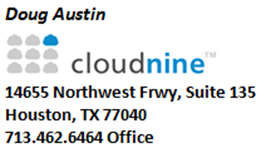eDiscovery Daily Blog
Email Signature Logos are a Sign That Discovery Will be More Complicated: eDiscovery Best Practices

Many, if not most of us, use some sort of graphic in our email signature at work that represents our corporate logo and many organizations have created a standard email signature for their employees to use when corresponding with others. It’s another subtle way of promoting brand recognition. But, those logos can add complexity when managing those emails in eDiscovery.
Craig Ball, in his excellent blog Ball in your Court, takes up the issue in his latest post (ESI Observations on a Pretty Good Friday), where he analyzes about 500GB of email containers associated with matters in which he has served as ESI Special Master. As he observes:
“Just three-fifths of the way through the data, I see 1,371,516 messages have been processed, and these messages have thrown off 1,262,552 GIF images. The great majority of these images will prove to be logos in the signature blocks of the messages, and account for 29% of the item count extracted from the data set so far.
Most of the GIF logos I see in this data are just 2.2KB; so, despite their numerousity, they account for only about ten percent of the volume of single messages (extracted MSGs) sans attachments.” (emphasis added)
As a consultant who has dealt with the corporate logo graphic issue many times in projects with my clients, I thought I would do my own quick analysis to see how some of our projects compare. As I have observed that logos are often in JPEG and PNG file formats as well, I compared the counts of email messages to GIF, JPG and PNG files in three recent different sized projects in CloudNine’s review platform, which provides a handy file type breakdown in its Analytics module.
Here’s the breakdown:
- Small project: Emails – 13,487; GIF/JPG/PNG – 10,492; 77.8% of emails.
- Medium project: Emails – 98,818; GIF/JPG/PNG – 66,205; 67.0% of emails.
- Large project: Emails – 443,350; GIF/JPG/PNG – 414,242; 93.4% of emails.
While clearly not all of these are corporate logo graphics (many are other embedded graphics, attached pictures, etc.), you do get the idea that these logos, repeated over and over again, can add up to a significant percentage of your collection on at least a file count basis.
Craig notes the eDiscovery complications these logos cause, including: adding data volumes throughout discovery, slowing page refreshes in review tools, wasting reviewer time and making review even more tedious as well as unnecessarily driving up the number of documents that have color and complicating identification of evidentiary documents where color needs to be preserved for its potential evidentiary value. He also notes that his “technically astute vendor colleagues may counter that there are programmatic methods to minimize the static and friction of corporate logos”, that “probably only a weirdo like me frets about corpulent GIF logos” and notes that “your corporate conceit isn’t ‘free.’”
Without a doubt, organizations don’t think about eDiscovery when crafting their corporate email signature standards and, as much as I can understand Craig’s question as to whether these color logos are worth it, I doubt that they’re going away any time soon. At CloudNine, our own email signature standards include our logo on new emails as we can’t resist any opportunity to show the “nine clouds” (eight white, one blue – the ninth cloud, get it?) in our admitted attempt to build brand recognition any way we can (at least our reply email signature standard is logo free). Try fighting the marketing guys on that.

Nonetheless, as certainly a “weirdo” who also likes to think of myself as a “technically astute vendor colleague”, I have dealt with these logos time and time again in client projects. So, tomorrow, we’ll talk about a couple of those techniques we have used to minimize the effect on our client projects.
So, what do you think? Do you find that corporate logo graphics files are adding complexity to your own eDiscovery processes? Please share any comments you might have or if you’d like to know more about a particular topic.
Disclaimer: The views represented herein are exclusively the views of the author, and do not necessarily represent the views held by CloudNine. eDiscoveryDaily is made available by CloudNine solely for educational purposes to provide general information about general eDiscovery principles and not to provide specific legal advice applicable to any particular circumstance. eDiscovery Daily should not be used as a substitute for competent legal advice from a lawyer you have retained and who has agreed to represent you.
